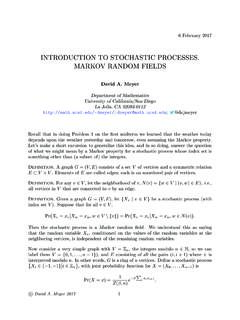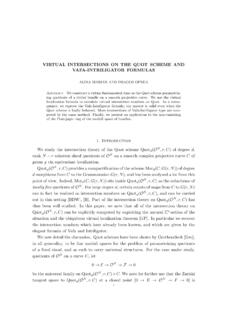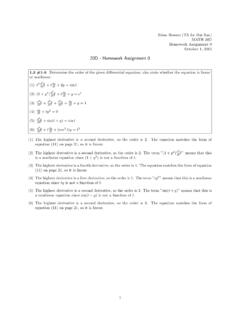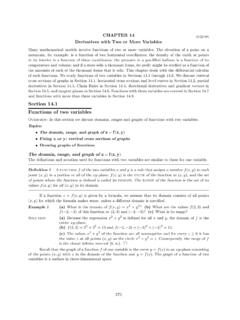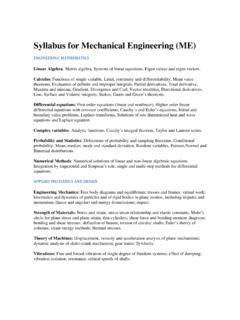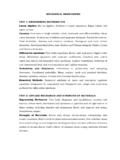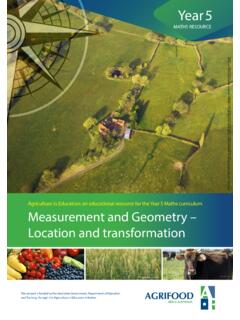Transcription of SOLUTIONS - UCSD Mathematics
1 SOLUTIONSP roblem the critical points of the functionf(x,y) = 2x3 3x2y 12x2 3y2and determine their type local min/local max/saddle point. Are there any global min/max?Solution:Partial derivativesfx= 6x2 6xy 24x,fy= 3x2 find the critical points, we solvefx= 0 = x2 xy 4x= 0 = x(x y 4) = 0 = x= 0orx y 4 = 0fy= 0 = x2+ 2y= 0we findy= 0from the second equation. In the second case, we solve the systembelow by substitutionx y 4 = 0,x2+ 2y= 0 = x2+ 2x 8 = 0= x= 2orx= 4 = y= 2ory= three critical points are(0,0),(2, 2),( 4, 8).To find the nature of the critical points, we apply the second derivative test. We haveA=fxx= 12x 6y 24, B=fxy= 6x, C=fyy= the point(0,0)we havefxx= 24,fxy= 0,fyy= 6 = AC B2= ( 24)( 6) 0>0 = (0,0)is local , we find(2, 2)is a saddle pointsinceAC B2= (12)( 6) ( 12)2=<0and( 4, 8)is saddlesinceAC B2= ( 24)( 6) (24)2< function has no global min sincelimy ,x=0f(x,y) = and similarly there is no global maximum sincelimx ,y=0f(x,y) =.
2 1 Problem the global max and min of the functionf(x,y) =x2 2x+ 2y2 2y+ 2xyover the compact region 1 x 1,0 y :We look for the critical points in the interior: f= (2x 2 + 2y,4y 2 + 2x) = (0,0) = 2x 2 + 2y= 4y 2 + 2x= 0 = y= 0,x= , the point(1,0)is not in the interior so we discard it for check the boundary. There are four lines to be considered: the linex= 1:f( 1,y) = 3 + 2y2 critical points of this function ofyare found by setting the derivative to zero: y(3 + 2y2 4y) = 0 = 4y 4 = 0 = y= 1withf( 1,1) = 1. the linex= 1:f(1,y) = 2y2 the derivative and setting it to0we find the critical pointy= 0. The corre-sponding point(1,0)is one of the corners, and we will consider it separately below. the liney= 0:f(x,0) =x2 the derivative and setting it to0we find2x 2 = 0 = x= 1. This gives thecorner(1,0)as before. the liney= 2:f(x,2) =x2+ 2x+ 4with critical pointx= 1which is again a , we check the four corners( 1,0),(1,0),( 1,2),(1,2).
3 The values of the functionfaref( 1,0) = 3,f(1,0) = 1,f( 1,2) = 3,f(1,2) = the boxed values we select the lowest and the highest to find the global min and global conclude thatglobal minimum occurs at(1,0)global maximum occurs at(1,2).Problem Lagrange multipliers, optimize the functionf(x,y) =x2+ (y+ 1)2subject to the constraint2x2+ (y 1)2 :We check for the critical points in the interiorfx= 2x,fy= 2(y+ 1) = (0, 1)is a critical second derivative testfxx= 2,fyy= 2,fxy= 0shows this a local minimum withf(0, 1) = check the boundaryg(x,y) = 2x2+ (y 1)2= 18via Lagrange multipliers. We compute f= (2x,2(y+ 1)) = g= (4x,2(y 1)).Therefore2x= 4x = x= 0or =122(y+ 1) = 2 (y 1).In the first casex= 0we getg(0,y) = (y 1)2= 18 = y= 1 + 3 2,1 3 2with valuesf(0,1 + 3 2) = (2 + 3 2)2,f(0,1 3 2) = (2 3 2) the second case =12we obtain from the second equation2(y+ 1) =y 1 = y= ,g(x,y) = 18 = x= ( 1, 3), the function takes the valuef( 1, 3) = ( 1)2+ ( 3 + 1)2= comparing all boxed values, it is clear the(0, 1)is the minimum, while(0,1 + 3 2)is the functionw=ex2ywherex=u v, y= the chain rule, compute the derivatives w u, w :We have w x= 2xyexp(x2y) = 2u v1uv2exp(u2v 1uv2)=2v3/2exp(uv) w y=x2exp(x2y) =u2vexp(uv) x u= v, x v=u2 v y u= 1u2v2, y v= w u= w x x u+ w y y u=2v3/2exp(uv) v u2vexp(uv) 1u2v2==2vexp(uv) 1vexp(uv)=1vexp(uv).
4 Similarly, w u= w x x u+ w y y u= uv2exp(uv).Problem 5.(i)For what value of the parametera, will the planesax+ 3y 4z= 2, x ay+ 2z= 5be perpendicular?(ii)Find a vector parallel to the line of intersection of the planesx y+ 2z= 2,3x y+ 2z= 1.(iii)Find the plane through the origin parallel toz= 4x 3y+ 8.(iv)Find the angle between the vectorsv= (1, 1,2),w= (1,3,0).(v)A plane has equationz= 5x 2y+ what values ofais the vector(a,1,12)normal to the plane?Solution:(i) The normal vectors to the two planes aren1= (a,3, 4), n2= (1, a,2).The planes are perpendicular ifn1,n2are perpendicular. We compute the dot productn1 n2= 0 = a 1 + 3 ( a) + ( 4) 2 = 0 = 2a 8 = 0 = a= 4.(ii) The vectors normal to the two planes aren1= (1, 1,2), n2= (3, 1,2).The line of intersection will be perpendicular to bothn1,n2. But so is the cross the line of intersection will be parallel to the cross productn1 n2= (1, 1,2) (3, 1,2) = (0,4,2).
5 (iii) The second plane must have the same normal vector hence the same coefficients forx,y, it passes through the origin, the equation isz= 4x 3y.(iv) We compute the angle using the dot productcos =v w||v|| ||w||= 2 6 10= 1 15.(v) The plane has the equation5x 2y z= 7 = 52x+y+12z=72hence a normal vector is( 52,1,12).Comparing with the vector we are given, we see thata= 6.(i)Compute the second degree Taylor polynomial of the functionf(x,y) =ex2 yaround(1,1).(ii)Compute the second degree Taylor polynomial of the functionf(x) = sin(x2)aroundx= .(iii)The second degree Taylor polynomial of a certain functionf(x,y)around(0,1)equals1 4x2 2(y 1)2+ 3x(y 1).Can the point(0,1)be a local minimum forf? How about a local maximum?Solution:(i) After computing all derivatives and substituting, we find the answer1 + 2(x 1) (y 1) + 3(x 1)2+12(y 1)2 2(x 1)(y 1).(ii) We havef( ) = first derivative isfx= 2xcosx2= fx( ) = 2 cos = 2.
6 The second derivative isfxx= 2 cosx2 2xsinx2= fxx( ) = Taylor polynomial is 2 (x ) (x )2= x2+ .(iii) From the Taylor polynomial we findfx(0,1) =fy(0,1) = 0so(0,1)is a critical point. We can find the second derivatives12fxx(0,1) = 4,12fyy(0,1) = 2, fxy(0,1) = the second derivative testAC B2= ( 8)( 4) 32>0, A= 8<0 = (0,1)is a local 7.(i)The temperatureT(x,y)in a long thin plane at the point(x,y)satisfies Laplace s equationTxx+Tyy= the functionT(x,y) = ln(x2+y2)satisfy Laplace s equation?(ii)For the functionf(x,y) = sin(x2+y2) ln(x4y4+ 1) tan(xy)is it true thatfxyxyy=fyyxyx?Solution:(i) We computeTx=2xx2+y2= Txx=2y2 2x2(x2+y2)2Ty=2yx2+y2= Tyy=2x2 2y2(x2+y2) ,Txx+Tyy=2y2 2x2(x2+y2)2+2x2 2y2(x2+y2)2= 0.(ii) The two derivatives are equal as the order in which derivatives are computed is the functionf(x,y) =x2y4.(i)Carefully draw the level curve passing through(1, 1). On this graph, draw the gradient of thefunction at(1, 1).
7 (ii)Compute the directional derivative offat(1, 1)in the directionu=(45,35).Use this calculationto estimatef((1, 1) +.01u).(iii)Find the unit directionvof steepest descent for the functionfat(1, 1).(iv)Find the two unit directionswfor which the derivativefw= :(i) The level isf(1,1) = level curve isf(x,y) =f(1,1) = 1 = x2=y4= x= level curve is a union of two parabolas through the origin. The gradient f=(2xy4, 4x2y5)= f(1, 1) = (2,4)is normal to the parabolas.(ii) We computefu= f u= (2,4) (45,35)= the approximation, we havef(1, 1) = 1andf((1, 1) +.01u) f(1, 1) +.01fu= 1 +.01 4 = (iii) The direction of steepest decrease is opposite to the gradient. We need to divide by thelength to get a unit vector:v= f|| f||= (2,4) 22+ 42=( 1 5, 2 5).(iv) Writew= (w1,w2).We havefw= f w= (2,4) w= 2w1+ 4w2= 0 = w1= unit lengthw21+w22= 1 = ( 2w2)2+w22= 1 = w2= 1 ( 2 5,1 5).Problem the functionf(x,y) = ln(e2xy3).
8 (i)Write down the tangent plane to the graph offat(2,1).(ii)Find the approximate value of the number ln( ( )3).Solution:(i) Using the chain rule, we computefx=122e2xe2x ln(e2xy3)=1 ln(e2xy3)= fx(2,1) =1 lne4=1 4= ,fy=123y2e2xy3e2x ln(e2xy3)=32y1 ln(e2xy3)= fy(2,1) =123 lne4=32 1 4= computef(2,1) = lne4= 4 = tangent plane isz 2 =12(x 2) +34(y 1) = z=12x+34y+14.(ii) The number we are approximating isf( , ) 12 +34 +14= thatz=e3x+2y, y= ln(3u w), x=u+ z v, z :By the chain rule z v= z x x v= 3e3x+2y 2 = 6e3xe2y= 6e3u+6ve2 ln(3u w)= 6e3u+6v(3u w) , z w= z y y w= 2e3x+2y 13u w= 2e3u+6ve2 ln(3u w) 13u w= 2e3u+6v(3u w)2 13u w= 2e3u+6v(3u w).Problem 11.(i)Findzsuch that1 +1z+1z2+1z3+..= 3.(ii)Calculate the series13+232+2233+..+ :(i) This is a geometric series with step1z. Its sum equals11 1z= 3 = 1 1z=13= z=32.(ii) This is a finite geometric series with100terms and initial term1/3and step2/3.
9 The sumequals13 1 (23)1001 23= 1 (23) probability density function for the outcomexof a certain experiment isp(x) =Ce x,forx 0.(i)What is the value of the constantC?(ii)What is the cumulative distribution function?(iii)What is the median of the experiment?(iv)What is the mean of the experiment?(v)What is the probability that the outcome of the experiment is bigger than1?Solution:(i) The pdf must integrate to1hence 0p(x)dx= 1 = C 0e x= 1 = C e x| x=0= 1 = C(0 1) = 1 = C= 1.(ii) The cdf is obtained by integrating the pdf:P(x) = x0p(t)dt= x0e tdt= e t|t=xt=0= 1 e x.(iii) To find the median, we set the pdf to1/2:P(T) =12= 1 e T=12= e T=12= T= ln 2.(iv) The mean is computed by the integralmean= 0xp(x)dx= 0xe x= last integral was found by integration by parts 0xe x= xe x| x=0+ 0e xdx= 0 + 0e xdx= e x| x=0= 1.(v) The probability the outcome is at most1isP(1) = 1 e probability thatx 1is1 P(1) =e the functionf(x,y) = 5 (x+ 1)2 y2.
10 (i)Draw the cross section corresponding tox= 1.(ii)Draw the contour diagram offshowing at least three levels.(iii)Draw the graph off.(iv)What is the equation of the tangent plane to the graph offat(1,0,1)?Solution:(i) The cross section is the parabolaz= 1 y2.(ii) The level curve for levelcisf(x,y) =c= (x+ 1)2+y2= 5 level curves are circles of centers( 1,0)and radius 5 c. For instance, picking levelsc= 1,c= 2,c= 4we get circles of radii2, 3,1of center( 1,0).(iii) The graph offis a downward pointing paraboloid with vertex at( 1,0,5).(iv) The partial derivativesfx= 2(x+ 1) = fx(1,0) = 4fy= 2y= fy(1,0) = tangent plane isz 1 = 4(x 1) + 0(y 0) = z= 4x+ the point on the plane2x+ 3y+ 4z= 29that is closest to the origin. You may want to minimize the square of the distance to the :We minimize the square of the distance to the originf(x,y,z) =x2+y2+z2subject to the constraintg(x,y,z) = 2x+ 3y+ 4z= use Lagrange multipliers f= (2x,2y,2z), g= (2,3,4).
